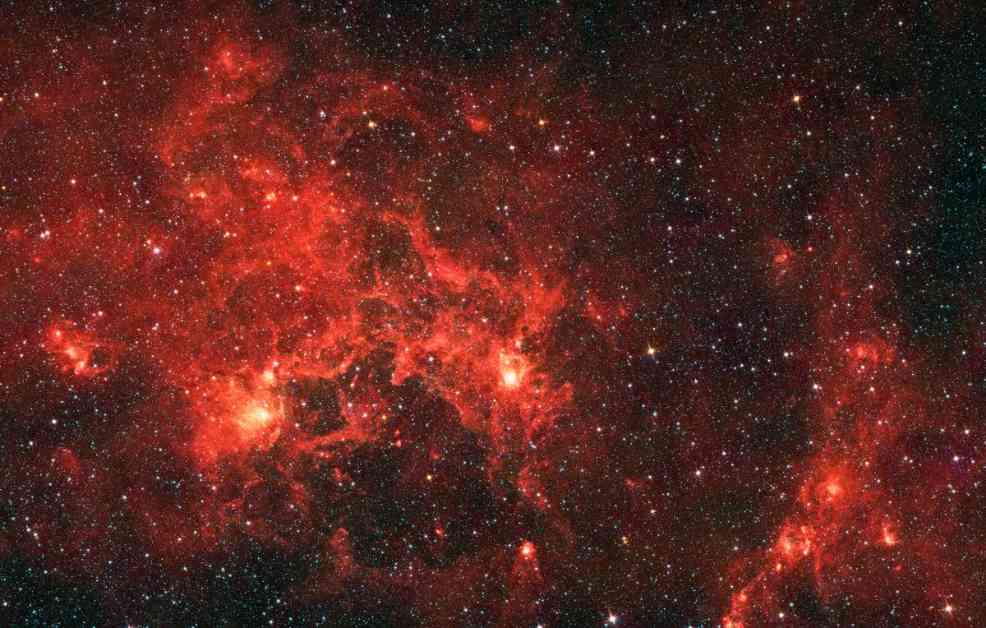In the vast expanse of the cosmos, our own Milky Way galaxy remains a mystery, with much of its unseen side shrouded in dust and obscured from view. Despite residing within its spiraling arms, we find ourselves at a disadvantage when it comes to mapping out the distant reaches and hidden wonders of our celestial home. While we can gaze outwards and observe other galaxies in their entirety, our own galactic backyard presents a unique challenge.
Imagine being in a fog-filled warehouse, able to see only a limited distance ahead, with the periphery obscured by a veil of mist. This analogy captures the predicament faced by astronomers trying to uncover the secrets of the Milky Way. The presence of billions of stars within our galaxy has created a thick layer of dust, hindering our ability to see beyond the stars that illuminate the night sky. This stellar fog limits our view, leaving us with a partial understanding of the galaxy we call home.
The Milky Way, a flat disk with a central bulge of stars, is a familiar sight on a clear night, appearing as a luminous band stretching across the sky. However, our knowledge of its structure is confined to what lies within our immediate vicinity. The stars we see are merely a fraction of what exists within our galaxy, prompting astronomers to delve deeper into the unseen realms of the Milky Way.
By harnessing the power of radio and infrared telescopes, scientists have begun to unravel the mysteries of the galactic far side. These longer wavelengths of light can penetrate the dust clouds that obscure visible light, providing a glimpse into the hidden corners of our galaxy. Through these innovative technologies, astronomers have discovered a multitude of fascinating phenomena that lie beyond our line of sight.
Peering into the Galactic Center
At the heart of the Milky Way lies a supermassive black hole known as Sagittarius A*, weighing more than four million suns. Despite being invisible to the naked eye, this colossal cosmic entity exerts a powerful gravitational pull on the surrounding stars, revealing its presence through their intricate dance. By studying the motions of these stars, astronomers have gained valuable insights into the dynamics of our galaxy’s central regions.
One of the most striking discoveries beyond the galactic center is the Dragonfish Nebula, a vast cloud of gas and dust where new stars are actively forming. Spanning an impressive 1,000 light-years in width, this nebula dwarfs its counterparts in size and serves as a testament to the hidden wonders of the Milky Way. While invisible to optical telescopes, the Dragonfish Nebula shines brightly in the infrared spectrum, offering a window into the cosmic processes unfolding in the far reaches of our galaxy.
Unveiling Cosmic Mysteries
The exploration of the Milky Way’s unseen side has also led to the identification of remarkable objects such as the supernova remnant G1.9+0.3 and the magnetar SGR 1806-20. These distant celestial phenomena, located over 27,000 and 40,000 to 50,000 light-years away respectively, have provided valuable insights into the nature of cosmic explosions and high-energy events occurring on the far side of our galaxy.
As astronomers continue to probe the hidden depths of the Milky Way, new discoveries await, offering a tantalizing glimpse into the vast uncharted territories that lie beyond our familiar night sky. From powerful Wolf-Rayet stars to potential exoplanets waiting to be found, the unseen side of our galaxy holds a treasure trove of celestial wonders, waiting to be unveiled by the curious minds of those who dare to explore its mysteries.
The exploration of the Milky Way’s hidden half is not just a scientific endeavor but a quest to expand our understanding of the universe and our place within it. As we peer into the depths of our galactic home, we are reminded of the vastness and complexity of the cosmos, urging us to continue our exploration and discovery of the unseen realms that lie beyond the stars. The journey to uncover the secrets of the Milky Way’s far side is far from over, promising new revelations and insights that will shape our understanding of the universe for generations to come.










